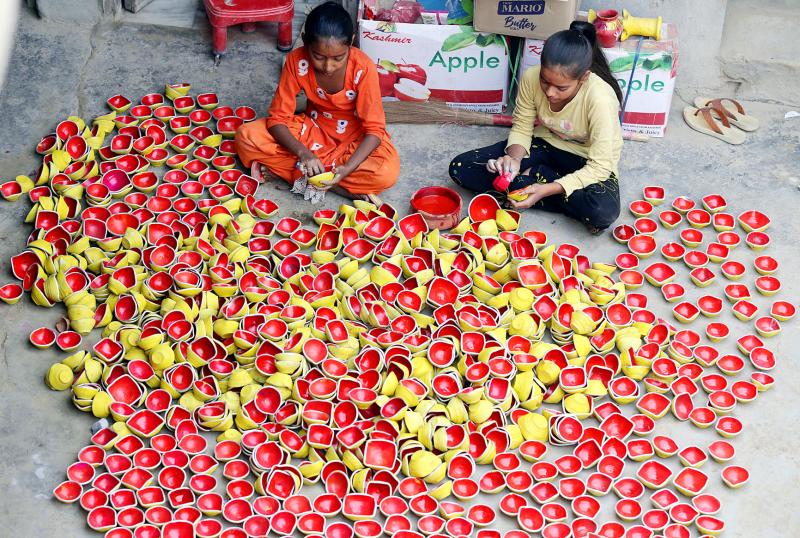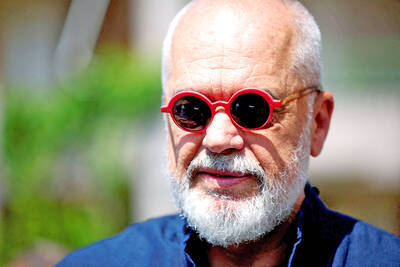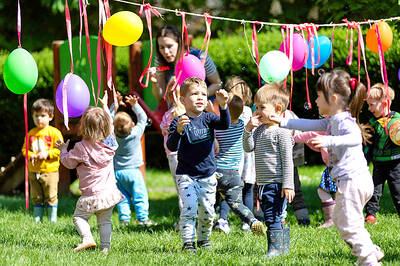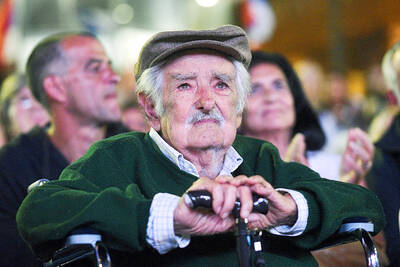India is on course to top the world in COVID-19 cases, but from Maharashtra’s whirring factories to Kolkata’s thronging markets, people are back at work — and eager to forget the pandemic for festival season.
After a strict lockdown in March that left millions on the brink of starvation, the government and people of the world’s second-most populous country decided life must go on.
Sonali Dange, for instance, has two young daughters and an elderly mother-in-law to look after. She was hospitalized this year in excruciating pain after catching the novel coronavirus.

Photo: EPA-EFE
However, after the lockdown exhausted the family’s savings, the 29-year-old had to return to work at a factory where she earns 25,000 rupees (US$340) a month.
“Now that I have recovered, I am no longer so scared of the disease,” she said amid the din of machinery at the Nobel Hygiene plant east of Mumbai.
The pandemic’s confirmed fatality rate has been heaviest in richer nations with older populations — the US death toll is double that of India, despite having only a quarter of the population.
Poor countries have suffered far worse economic pain, with the World Bank predicting 150 million people could fall into extreme poverty worldwide.
Many children in the developing world are now working to help their parents make ends meet, activists say, while thousands of young girls have been forced into marriage.
In Varanasi in northern India, 12-year-old Sanchit no longer attends school and instead collects cloth discarded from bodies before cremation on the city’s ghats (steps leading down to a river).
“On a good day, I earn about 50 rupees,” he said.
The IMF projects India’s GDP would contract by 10.3 percent this year, the biggest slump of any major emerging nation and its worst since independence in 1947.
When India went into lockdown, it was a human catastrophe, leaving millions in the informal economy jobless, penniless and destitute almost overnight.
No one wants to go back to that, said Gargi Mukherjee, 42, as she shopped in the New Market area of Kolkata, thronging with festival-season customers, many without masks.
“For survival, people have to come out and do their jobs. If you don’t earn, you cannot feed your family,” she said.
Experts warn that the October-November season — when Hindus celebrate major festivals such as Durga Puja, Dussehra and Diwali — might trigger a sharp increase in infections, as consumers crowd markets to snap up big-ticket items on discount.
“Of course corona is to be feared. But what can I do? I can’t miss the moments of Durga Puja,” said housewife Tiyas Bhattacharya Das, 25. “Durga Puja comes once in the year, so I cannot miss the enjoyment of the shopping.”
Sunil Kumar Sinha, principal economist at the Mumbai-based India Ratings and Research agency, said Indians faced a stark choice.
“People have to choose whether to die of hunger or risk getting a virus that may or may not kill you,” he said.
Indeed India’s relatively low mortality rate — about 1.5 percent of its more than 7 million cases — has surprised many who warned COVID-19 would lay waste to its crowded cities, beset by poor sanitation and crumbling public hospitals.
Even accounting for some likely undercounting, it is evident that the nightmare scenario of dead bodies piled in the streets as seen during the 1918 flu pandemic has mercifully not materialized.
The unexpected reprieve has given Indian Prime Minister Narendra Modi leeway to resist a fresh lockdown, with the human toll — and political cost — of another shutdown higher than seeing case numbers soar.
However, Bhramar Mukherjee, an epidemiologist at the University of Michigan, said the government should not simply let the virus run its course.
“In order to open up, you need to intensify public health measures... If you completely take your foot off the brakes, the virus will take off too,” Mukherjee said.
Last month, the Indian Medical Association slammed the Modi government for its “indifference” to the sacrifices of front-line staff in one of the world’s worst-funded healthcare systems.
“It appears that they are dispensable,” it said.
In Kolkata, bookseller Prem Prakash, 67, was philosophical.
“You have to leave some things to fate,” he said. “Fearing death too much is not a solution. When that comes, you should accept it gracefully.”

FRAUD ALLEGED: The leader of an opposition alliance made allegations of electoral irregularities and called for a protest in Tirana as European leaders are to meet Albanian Prime Minister Edi Rama’s Socialist Party scored a large victory in parliamentary elections, securing him his fourth term, official results showed late on Tuesday. The Socialist Party won 52.1 percent of the vote on Sunday compared with 34.2 percent for an alliance of opposition parties led by his main rival Sali Berisha, according to results released by the Albanian Central Election Commission. Diaspora votes have yet to be counted, but according to initial results, Rama was also leading there. According to projections, the Socialist Party could have more lawmakers than in 2021 elections. At the time, it won 74 seats in the

A Croatian town has come up with a novel solution to solve the issue of working parents when there are no public childcare spaces available: pay grandparents to do it. Samobor, near the capital, Zagreb, has become the first in the country to run a “Grandmother-Grandfather Service,” which pays 360 euros (US$400) a month per child. The scheme allows grandparents to top up their pension, but the authorities also hope it will boost family ties and tackle social isolation as the population ages. “The benefits are multiple,” Samobor Mayor Petra Skrobot told reporters. “Pensions are rather low and for parents it is sometimes

CONTROVERSY: During the performance of Israel’s entrant Yuval Raphael’s song ‘New Day Will Rise,’ loud whistles were heard and two people tried to get on stage Austria’s JJ yesterday won the Eurovision Song Contest, with his operatic song Wasted Love triumphing at the world’s biggest live music television event. After votes from national juries around Europe and viewers from across the continent and beyond, JJ gave Austria its first victory since bearded drag performer Conchita Wurst’s 2014 triumph. After the nail-biting drama as the votes were revealed running into yesterday morning, Austria finished with 436 points, ahead of Israel — whose participation drew protests — on 357 and Estonia on 356. “Thank you to you, Europe, for making my dreams come true,” 24-year-old countertenor JJ, whose

CANCER: Jose Mujica earned the moniker ‘world’s poorest president’ for giving away much of his salary and living a simple life on his farm, with his wife and dog Tributes poured in on Tuesday from across Latin America following the death of former Uruguayan president Jose “Pepe” Mujica, an ex-guerrilla fighter revered by the left for his humility and progressive politics. He was 89. Mujica, who spent a dozen years behind bars for revolutionary activity, lost his battle against cancer after announcing in January that the disease had spread and he would stop treatment. “With deep sorrow, we announce the passing of our comrade Pepe Mujica. President, activist, guide and leader. We will miss you greatly, old friend,” Uruguayan President Yamandu Orsi wrote on X. “Pepe, eternal,” a cyclist shouted out minutes later,